#Automated External Defibrillator (AED) Market
Explore tagged Tumblr posts
Text
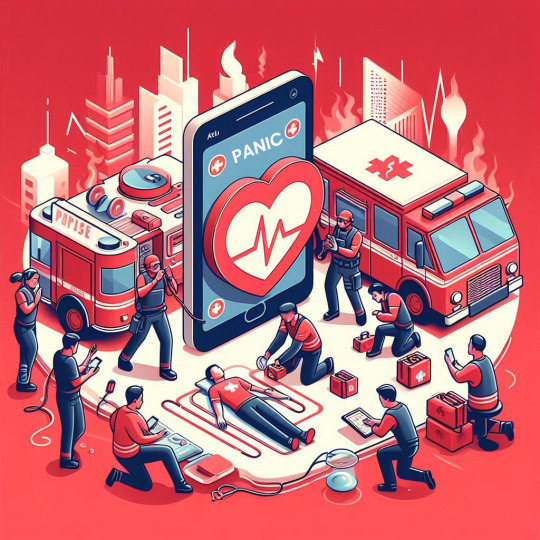
From Panic to Prepared: How Our App Simplifies CPR in High-Stress Situations
In a world where emergencies can strike at any moment, being prepared can mean the difference between life and death. Cardiac arrests don’t come with a warning, and when they happen, panic often takes over. But what if you could transform that panic into preparedness? Enter the Revive CPR App, the revolutionary app designed to simplify CPR and empower you to act confidently in high-stress situations.
In this blog, we’ll explore how our app is changing the game, making CPR accessible, easy to learn, and stress-free—even for those with no medical background. Let’s dive in!
Why CPR Matters: The Lifesaving Skill Everyone Should Know
Every year, over 350,000 cardiac arrests occur outside of hospitals in the U.S. alone. Sadly, nearly 90% of these cases are fatal, often because bystanders don’t know how to perform CPR or are too afraid to try.
The truth is, CPR can double or even triple a victim’s chance of survival. But in the heat of the moment, fear and uncertainty can paralyze even the most well-meaning individuals. That’s where Revive CPR App comes in.
The Problem: Panic in High-Stress Situations
When faced with an emergency, our brains often go into fight-or-flight mode. This can lead to:
Confusion: Forgetting the steps of CPR.
Fear: Worrying about doing more harm than good.
Delay: Hesitating to act, wasting precious time.
Traditional CPR training, while valuable, doesn’t always prepare us for the adrenaline rush of a real-life emergency. That’s why we created an app that bridges the gap between knowledge and action.
How Revive CPR App Simplifies CPR:
Our app is designed to cut through the chaos and guide you step-by-step, ensuring you stay calm and focused. Here’s how it works:
1. Real-Time CPR Guidance
With intuitive audio and visual prompts, the app walks you through the entire CPR process. From chest compressions to rescue breaths, it’s like having a personal CPR coach in your pocket.
2. Quick Access to Emergency Services
The app integrates with your phone’s GPS to connect you with local emergency services instantly. It also provides directions to the nearest AED (Automated External Defibrillator), if available.
3. Confidence-Building Tools
Practice makes perfect. Our app includes a CPR simulator that lets you practice on a virtual patient, building muscle memory and boosting your confidence.
Why Revive CPR App Stands Out
In a crowded market of health and safety apps, here’s what makes us unique:
User-Friendly Design: No complicated menus or jargon—just clear, actionable instructions.
Community Impact: Join a network of lifesavers and share your experiences to inspire others.
Be the Hero in Someone’s Story
Emergencies are unpredictable, but your reaction can be prepared. With Revive CPR App, you can go from panic to prepared in seconds. Whether you’re a parent, teacher, or just someone who wants to make a difference, this app is your ultimate lifesaving tool.
Download Revive CPR App Today
Don’t wait for an emergency to realize the importance of being prepared. Download Revive CPR App now and join the movement to create a safer, more confident world. Together, we can turn panic into preparedness—one heartbeat at a time.
#cpr and aed#doctor#doctor aditya kapoor#doctor kinjil goyal#doctor manju sinha#revive heart foundation#doctor yash lokhandwala#doctor yash#public health#revive heart
2 notes
·
View notes
Text
1 Day Emergency First Aid Course
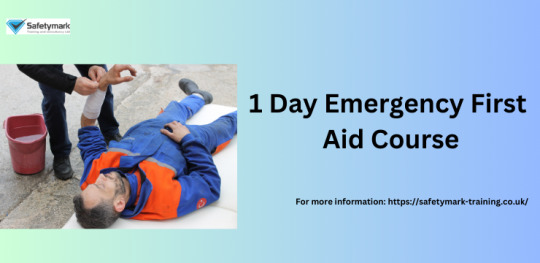
Introduction: Having the information and abilities to react appropriately can significantly impact the saving of lives in an emergency, which can occur anywhere and at any moment. In addition to teaching you the fundamentals of lifesaving skills, a 1-day emergency first aid course also offers you a Safetymark Training and Consultancy, which guarantees that you are adequately prepared to safely and professionally handle unforeseen circumstances.
The Value of First Aid Training for Emergencies
Quick Reaction: Moments matter while dealing with emergencies. A one-day emergency first aid course will help you increase the likelihood that the sufferer will recover by teaching you how to respond swiftly to circumstances and offer assistance right away.
Basic Life Support: You will acquire the skills necessary to do artificial breathing and maintain circulation in an individual experiencing cardiac arrest. This includes learning how to perform cardiopulmonary resuscitation (CPR).
Handling Injuries: This course teaches you how to reduce damage and avoid infections by covering bandaging, stopping bleeding, and wound care techniques for both minor cuts and severe wounds.
Handling Choking: Acquire the Heimlich maneuver, an essential ability for freeing an individual's airway from obstructions and perhaps preventing asphyxia.
Comprehension of AED Usage: In the event of a cardiac arrest, automated external defibrillators, or AEDs, are essential for reestablishing a normal cardiac rhythm. Learn how to operate an AED safely and successfully with the help of this course.
The Certification for Safetymark Training and Consultancy
Getting a safetymark-training.co.uk in addition to your one-day course in emergency first aid has various benefits.
Accreditation that is Respected: SafetyMark Consultancy has an extensive international reputation. It displays your proficiency in emergency first aid and your training from a respected institution.
Improved Employability: SafetyMark is highly valued by many businesses when selecting new hires, particularly for positions where first aid knowledge is essential. Possessing this certification might help you stand out from the competition in the employment market.
Self-assurance and preparedness: Possessing the Safetymark Training & Consultancy gives you self-assurance in your capacity to manage crises. It gives others and yourself confidence that you can help someone right away when they need it.
Impact on the Community: By volunteering your expertise in the event of an accident, a natural catastrophe, or other emergency, you may use your SafetyMark to actively support your community and improve the lives of others.
Final Thought
Enrolling in safetymark-training.co.uk's 1-Day Emergency First Aid Course is a small investment that will pay off greatly. Having these life-saving abilities and receiving the esteemed SafetyMark not only increases your employability but also makes you a ray of hope during emergencies. Recall that being ready now can have a huge impact tomorrow.
2 notes
·
View notes
Text
Why Is the Global Defibrillator Market Accelerating in 2025 — And What It Means for Healthcare Leaders?

The global defibrillator market is undergoing a transformational phase in 2025, backed by robust demand, technological breakthroughs, and strategic public health initiatives. Valued at US$11.99 billion in 2025, the market is forecasted to reach US$16.44 billion by 2030, propelled by a strong 6.5% CAGR. For C-level executives in the medtech, hospital administration, and investment sectors, this market presents a timely and strategic opportunity.
This blog dissects what’s fueling this growth, why it's gaining executive-level attention, and how businesses can position themselves for success in the evolving defibrillator ecosystem.
Download an Illustrative overview
What Is Driving Growth in the Global Defibrillator Market?
1. Rise in Cardiovascular Disease (CVD) Cardiovascular diseases remain the leading cause of death globally. In the U.S. alone, over 61% of adults are expected to live with some form of CVD by 2050. This alarming trend is mirrored in emerging markets like India and China, where lifestyle-related conditions such as hypertension, obesity, and diabetes are on the rise.
These conditions increase the risk of sudden cardiac arrest, making defibrillators—especially Implantable Cardioverter Defibrillators (ICDs)—a critical component in cardiac emergency response.
2. Expansion of Public Access Programs Government initiatives across North America and Europe are driving the installation of Automated External Defibrillators (AEDs) in public spaces, airports, malls, and schools. Simultaneously, awareness programs and CPR training are improving public readiness, reducing the time-to-shock window and enhancing survival outcomes.
3. Technological Innovation Modern defibrillators are evolving beyond basic shock delivery. Features such as wireless remote monitoring, AI-powered arrhythmia detection, Bluetooth connectivity, and MRI compatibility are setting new standards. Devices like Medtronic’s Cobalt XT and Boston Scientific’s RESONATE are leading this transformation, offering precision care and patient-centric innovation.
Why Are Implantable Cardioverter Defibrillators (ICDs) Dominating the Market?
ICDs account for the largest share of the defibrillator market due to their continuous monitoring and automatic therapeutic intervention capabilities. Their ability to detect and treat life-threatening ventricular arrhythmias—without external input—makes them vital for high-risk patients.
Advancements in ICDs also include:
Extended battery life
Smaller form factors
Remote monitoring tools for clinicians
Reimbursement models that support accessibility in developed regions
As a result, ICDs are not just clinical devices—they are strategic tools for healthcare systems aiming to reduce mortality and hospital readmissions.
Where Are the Major Opportunities for Market Expansion?
North America With an anticipated market size of US$7.28 billion by 2030, North America remains the largest and most mature defibrillator market. The U.S., in particular, is the fastest-growing sub-market driven by:
Advanced R&D investments
Favorable regulatory frameworks
Widespread insurance coverage
Presence of top medtech players (e.g., Abbott, Stryker, Boston Scientific)
Asia Pacific Emerging economies such as India, China, and Vietnam offer high-growth potential, attributed to:
Rapid urbanization and industrialization
Rising incidence of cardiac conditions
Evolving healthcare infrastructure
Government-backed AED installation initiatives
Companies like Nihon Kohden and MicroPort are strategically entering these markets via local subsidiaries and product launches tailored for cost-sensitive environments.
Who Are the Key Players Reshaping the Defibrillator Ecosystem?
The market is dominated by innovation-focused medtech giants:
Medtronic (Ireland) – Known for ICD product lines with real-time connectivity
Boston Scientific (US) – Acquiring Bolt Medical and launching RESONATE with remote monitoring
Stryker (US) – Introducing LIFEPAK 35 defibrillator with modernized interface
Philips (Netherlands) – Investing in R&D hubs like Pune to innovate and scale
MicroPort (China) – Expanding European reach with Bluetooth-enabled ICDs and CRT-Ds
Their strategies—mergers, acquisitions, and geographic expansion—are setting the tone for market competitiveness and product diversification.
When Will Emerging Markets Outpace Developed Regions?
While developed markets currently lead, emerging economies are expected to overtake in growth rate during the 2025–2030 forecast period. Countries like China are projected to see a 50% rise in annual cardiovascular events from 2010 levels by 2030.
With favorable regulatory pathways, growing middle-class populations, and public-private healthcare initiatives, companies that localize production and offer scalable, affordable defibrillator solutions stand to gain a first-mover advantage.
How Should Business Leaders Prepare for the Next Phase of Growth?
To leverage the defibrillator market’s potential, executives must:
Invest in Emerging Markets – Target high-population regions with underserved cardiac care.
Drive Innovation – Enhance features like AI, IoT connectivity, and predictive diagnostics.
Strengthen Regulatory Navigation – Stay ahead in approval pipelines and recall prevention.
Expand Training & Awareness – Partner with governments and NGOs for CPR and AED programs.
Develop B2G and B2B Sales Models – Focus on institutional sales to hospitals, governments, and EMS providers.
Conclusion: Strategic Outlook for 2025 and Beyond
The global defibrillator market is not just growing—it’s transforming. From saving lives in emergency rooms to being embedded in public infrastructure and homes, defibrillators are becoming central to the modern cardiac care continuum.
With a strategic approach—centered on innovation, access, and education—healthcare leaders and investors can align with a market that is as impactful as it is profitable.
As sudden cardiac arrest awareness grows and healthcare systems evolve, the time to lead in the defibrillator space is now.Buy Defibrillator Industry Report (217 Pages PDF with Insightful Charts, Tables, and Figures)
0 notes
Text
Resuscitation Devices Market Insights into Technological Advancements and R&D Focus 2032
In 2024, the global resuscitation devices market was valued at USD 5.06 billion and is projected to grow from USD 5.38 billion in 2025 to USD 9.00 billion by 2032, reflecting a compound annual growth rate (CAGR) of 7.6% over the forecast period.
The resuscitation devices market is experiencing robust growth, fueled by increasing incidence of sudden cardiac arrests, respiratory emergencies, and critical care scenarios across healthcare and emergency response settings. This market encompasses a variety of essential devices—including automated external defibrillators (AEDs), manual defibrillators, ventilators, suction units, and infant resuscitation tools—designed to support life-saving interventions in hospitals, ambulances, and public spaces. Rising awareness of early intervention protocols (e.g., "chain of survival"), expanded deployment of portable and user-friendly devices in public areas, and growing adoption in emerging markets are key drivers. Technological advancements such as integration with IoT, real-time monitoring, and automated analytics enhance device performance and patient outcomes. Additionally, favorable regulatory developments, training initiatives, and increased funding in emergency care infrastructure are further propelling market uptake. As demand for improved emergency preparedness continues to grow, the resuscitation devices market is projected to expand steadily in the coming years.
Continue reading for more details:
Market Segmentation
By Product Type: The Resuscitation Devices Market segments into manual resuscitators, automatic ventilators, cardiac defibrillators, and airway adjuncts.
By End-User: Hospitals, emergency medical services (EMS), ambulatory surgical centers, and home care settings form key segments of the Resuscitation Devices Market.
By Technology: Portable, battery-operated devices versus fixed, plug-in systems differentiate segments within the Resuscitation Devices Market.
By Distribution Channel: Direct sales, distributor networks, e‑commerce platforms, and retail medical outlets represent distribution paths in the Resuscitation Devices Market.
List Of Top Resuscitation Devices Market Companies:
Koninklijke Philips N.V. (Netherlands)
Hamilton Medical (Switzerland)
Getinge AB (Sweden)
Medtronic (Ireland)
Teleflex Incorporated (U.S.)
Convatec Group PLC (U.K.)
Ambu A/S (Denmark)
Flexicare Medical Limited (U.K.)
ICU Medical (U.S.)
ZOLL Medical Corporation (Asahi Kasei) (U.S.)
Stryker (U.S.)
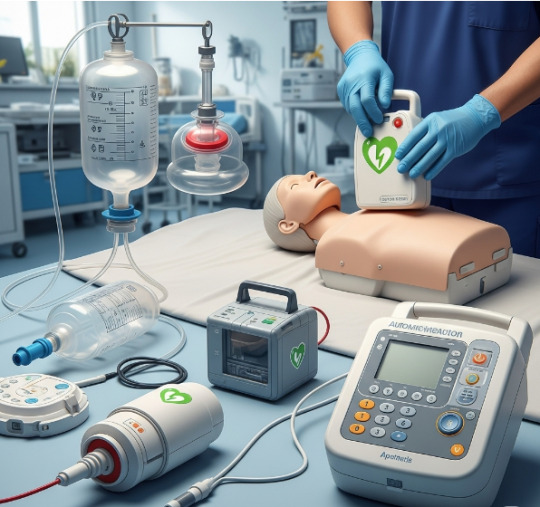
Market Growth
The Resuscitation Devices Market has witnessed consistent expansion, driven by increasing prevalence of cardiac and respiratory emergencies in both developed and developing regions.
Technological advancements in defibrillators, ventilators, and airway management tools have significantly propelled the Resuscitation Devices Market forward.
Rising investments in emergency healthcare infrastructure and training programs support sustained growth of the Resuscitation Devices Market.
Greater public awareness campaigns and regulatory support for life-saving equipment continue to elevate demand within the Resuscitation Devices Market.
Regional Analysis
North America: Dominates the Resuscitation Devices Market, with strong hospital infrastructure, high healthcare spending, and early adoption of innovative technologies.
Europe: A mature Resuscitation Devices Market, led by countries with robust emergency care systems and policies promoting AED use in public spaces.
Asia-Pacific: Rapidly growing Resuscitation Devices Market, fueled by expanding EMS infrastructure in urban centers and rising healthcare budgets.
Latin America & Middle East/Africa: Emerging markets for the Resuscitation Devices Market, with gradual uptake tied to improved healthcare access and increasing government initiatives.
Contact Us:
Fortune Business Insights™ Pvt. Ltd.
9th Floor, Icon Tower,
Baner - Mahalunge Road,
Baner, Pune-411045,
Maharashtra, India.
Phone:
U.S.: +1 424 253 0390
U.K.: +44 2071 939123
APAC: +91 744 740 1245
Email: [email protected]
0 notes
Text
How the Defibrillator Market is Evolving: Technological Advances and Market Dynamics

Executive Summary
The global defibrillator market is poised for substantial growth, projected to expand from USD 14.92 billion in 2023 to USD 24.79 billion by 2031, reflecting a compound annual growth rate (CAGR) of 6.8% during the forecast period . This growth is driven by increasing incidences of cardiovascular diseases, technological advancements in defibrillator devices, and heightened public awareness of cardiac health.
Request Sample Report PDF (including TOC, Graphs & Tables): https://www.statsandresearch.com/request-sample/40437-global-defibrillator-market
Defibrillator Market Segmentation
By Product Type
Implantable Cardioverter Defibrillators (ICDs): ICDs held a significant market share in 2023, driven by their efficacy in managing life-threatening arrhythmias and the rising prevalence of cardiovascular diseases. Technological advancements, such as MRI-compatible and subcutaneous ICDs, are expected to further propel this segment.
External Defibrillators (EDs): This segment is anticipated to witness the fastest growth, attributed to increased public access initiatives and the ease of use of automated external defibrillators (AEDs) .
Wearable Cardioverter Defibrillators (WCDs): WCDs are gaining traction due to their non-invasive nature and suitability for patients at temporary risk of sudden cardiac arrest.
Get up to 30%-40% Discount: https://www.statsandresearch.com/check-discount/40437-global-defibrillator-market
By End-Use
Hospitals and Clinics: This segment dominated the market in 2023, accounting for over 79% of the revenue share, owing to the high volume of cardiac procedures and the availability of advanced medical infrastructure.
Public Access Settings: The public access segment is expected to register the fastest CAGR, driven by government mandates and awareness campaigns promoting AED installations in public spaces.
Prehospital Care Settings: Emergency medical services (EMS) are increasingly equipped with portable defibrillators to provide immediate care during patient transport.
Home Care: The home care segment is expanding, particularly for patients with known heart conditions, facilitated by the availability of user-friendly AEDs.
Defibrillator Market Regional Analysis
North America
North America led the global defibrillator market in 2023, capturing over 42% of the revenue share. Factors contributing to this dominance include a high prevalence of cardiovascular diseases, advanced healthcare infrastructure, and proactive government initiatives.
Asia-Pacific
The Asia-Pacific region is projected to experience the fastest growth during the forecast period. This growth is attributed to increasing healthcare expenditures, rising awareness of cardiac health, and government programs promoting the installation of AEDs in public areas.
Europe
Europe holds a significant market share, supported by well-established healthcare systems and ongoing research and development activities in cardiac care technologies.
Competitive Landscape
The defibrillator market is characterized by the presence of several key players focusing on product innovation, strategic partnerships, and mergers and acquisitions to strengthen their market position. Notable companies include:
Medtronic
Abbott Laboratories
Boston Scientific Corporation
Philips Healthcare
ZOLL Medical Corporation
Stryker Corporation
Nihon Kohden Corporation
Schiller AG
Defibrillator Market Drivers
Rising Incidence of Cardiovascular Diseases: The global increase in heart-related ailments necessitates effective emergency response devices like defibrillators.
Technological Advancements: Innovations such as MRI-compatible ICDs, wearable defibrillators, and user-friendly AEDs are enhancing device efficacy and patient compliance.
Government Initiatives: Policies mandating the installation of AEDs in public spaces and funding for cardiac health programs are boosting market growth.
Defibrillator Market Challenges
High Costs: The substantial investment required for advanced defibrillator devices can be a barrier, particularly in developing regions.
Lack of Awareness: Inadequate knowledge about the use and importance of defibrillators hampers their adoption, especially in rural areas.
Purchase Exclusive Report: https://www.statsandresearch.com/enquire-before/40437-global-defibrillator-market
Future Outlook
The defibrillator market is expected to continue its upward trajectory, driven by technological innovations and increasing global health awareness. Emphasis on developing cost-effective and user-friendly devices will be crucial in expanding market reach, particularly in emerging economies.
Our Services:
On-Demand Reports: https://www.statsandresearch.com/on-demand-reports
Subscription Plans: https://www.statsandresearch.com/subscription-plans
Consulting Services: https://www.statsandresearch.com/consulting-services
ESG Solutions: https://www.statsandresearch.com/esg-solutions
Contact Us:
Stats and Research
Email: [email protected]
Phone: +91 8530698844
Website: https://www.statsandresearch.com
0 notes
Text
0 notes
Text
Automated External Defibrillators Market Driving Demand Through Rising Cardiac Emergencies and Public Health Awareness
The Automated External Defibrillators Market is undergoing significant transformation, driven by growing awareness about sudden cardiac arrest (SCA) and the vital role AEDs play in saving lives. With the increasing prevalence of cardiovascular diseases and lifestyle-related health conditions, the global demand for AEDs has surged. Public access to AEDs in airports, malls, gyms, and other high-footfall areas has become a central focus of health and safety initiatives. Governments, healthcare providers, and even non-healthcare institutions are recognizing the importance of making AEDs readily available to reduce mortality rates.

Rising Demand Due to Growing Incidences of Sudden Cardiac Arrest One of the primary factors fueling the demand for AEDs is the alarming increase in sudden cardiac arrest incidents globally. According to the American Heart Association, more than 350,000 out-of-hospital cardiac arrests occur annually in the United States alone. Many of these deaths can be prevented with the timely use of AEDs, which provide an electric shock to restore normal heart rhythm. As awareness campaigns and survival stories reach more people, there is a growing emphasis on deploying AEDs in both public and private settings.
The demand is also being fueled by the aging population, which is more susceptible to cardiac conditions. Elderly individuals often have underlying heart-related ailments, which makes the availability of AEDs critical in residential communities, nursing homes, and elderly care centers. Moreover, countries across Asia-Pacific and Europe are experiencing a significant rise in cardiovascular diseases, making AED deployment essential for public health safety.
Technological Advancements Enhancing AED Accessibility and Usability The demand is further reinforced by innovations that make AEDs more user-friendly and accessible to non-medical professionals. Modern AEDs now come with voice prompts, visual indicators, and real-time feedback systems that guide users through the process of resuscitation. These features help even untrained bystanders to use AEDs effectively during emergencies, increasing survival rates.
Additionally, the integration of Internet of Things (IoT) and artificial intelligence (AI) in AED systems is revolutionizing the market. These technologies ensure that devices are always functional, automatically alert emergency services, and maintain usage logs for future analysis. These innovations are making AEDs more efficient and reliable, thereby driving their demand in healthcare and non-healthcare sectors alike.
Government Initiatives and Mandates Boosting Deployment Government regulations and awareness programs are significantly contributing to the increase in AED demand. Several countries have enacted laws mandating AED installations in public spaces. For example, in the U.S., many states have legislated the availability of AEDs in schools, sports facilities, and even corporate offices.
Likewise, initiatives like the European Resuscitation Council’s push for public AED access and Japan's comprehensive deployment of AEDs in metro stations and public parks underscore the global emphasis on preparedness. These programs often include training modules for employees and first responders, further promoting AED usage and demand.
Market Penetration Across Non-traditional Sectors AEDs are no longer confined to hospitals and ambulances. Their presence in educational institutions, transportation hubs, fitness centers, and corporate environments highlights the growing demand in non-traditional sectors. This shift is not only widening the market base but also emphasizing the AED’s role as an essential public safety tool.
Moreover, corporate social responsibility (CSR) initiatives by large corporations now include health and safety investments, with AED deployment being a key component. These practices not only save lives but also enhance a company’s reputation, thereby encouraging broader AED adoption.
Challenges and Opportunities While the demand for AEDs is on the rise, challenges such as high initial costs and maintenance requirements still exist, especially in low- and middle-income countries. However, opportunities lie in rental AED programs, government subsidies, and partnerships with NGOs to facilitate distribution in underserved regions.
The growing e-commerce sector is also playing a role in making AEDs more accessible. Online sales platforms offer a variety of AED models with competitive pricing and delivery options, thus contributing to market expansion.
Conclusion In summary, the Automated External Defibrillators Market is witnessing robust demand driven by rising cardiac emergency cases, technological innovations, government mandates, and expanding applications across various sectors. As the focus on preventive healthcare continues to grow, the global AED market is expected to experience sustained expansion in the coming years.
0 notes
Text
Automated First Aid Market Size, Demand & Share Insights | Global Industry Growth Analysis 2034
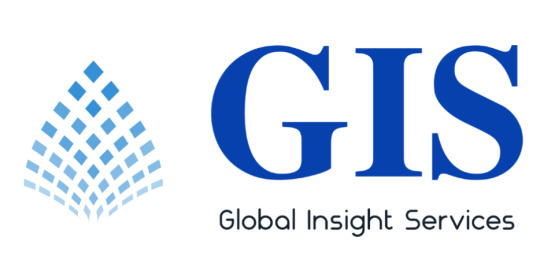
Advanced Automated First Aid Market is set for remarkable expansion, projected to grow from $4.2 billion in 2024 to $9.8 billion by 2034, reflecting a strong CAGR of 8.8%. This market comprises innovative emergency response tools that integrate automation and smart technologies, including automated external defibrillators (AEDs), intelligent first aid kits, wearable health monitors, and AI-based response systems. These technologies are transforming traditional first aid by reducing response time and enabling more accurate, real-time intervention, especially in critical and time-sensitive scenarios.
Market Dynamics
The growth of the advanced automated first aid sector is largely fueled by rising awareness of occupational safety, technological breakthroughs in healthcare devices, and a push towards real-time monitoring and assistance.
Click to Request a Sample of this Report for Additional Market Insights: https://www.globalinsightservices.com/request-sample/?id=GIS10816
The increasing use of wearable medical technology is particularly driving momentum, offering individuals and workplaces the ability to monitor health vitals and respond instantly during emergencies. Medical drones are also reshaping emergency response by delivering first aid kits to remote or inaccessible areas. However, the market still faces challenges such as high initial investment costs, integration complexities, limited awareness, and data privacy concerns.
Key Players Analysis
Several global players are at the forefront of this dynamic market. Philips Healthcare, Zoll Medical Corporation, and Medtronic are leading the innovation race with AI-enabled AEDs and cloud-connected systems. Other notable players include Laerdal Medical, Stryker, Defibtech, Cardiac Science, and CU Medical Systems. These companies are leveraging strategic collaborations, R&D investments, and user-centric product design to maintain a competitive edge. Additionally, a rising cohort of emerging players such as Aid Smart Technologies, Rescue Bot Innovations, and Swift Response Devices is introducing new technologies aimed at enhancing portability, ease of use, and affordability.
Regional Analysis
North America remains the dominant region in the Advanced Automated First Aid Market due to robust healthcare infrastructure, strong regulatory frameworks, and early adoption of AI and IoT in medical devices. The United States leads the charge with widespread workplace safety policies and tech-driven healthcare solutions.
Europe, particularly Germany and the United Kingdom, follows closely, spurred by stringent safety regulations and government-backed health initiatives. Their focus on smart city development and digital health integration boosts the adoption of automated first aid systems.
Asia-Pacific emerges as a rapidly growing region, with countries like China and India increasing investments in healthcare tech. The region benefits from expanding industrialization and a rising middle class prioritizing health and safety.
Latin America and the Middle East & Africa are gradually growing, with Brazil, Mexico, and South Africa showing potential despite challenges like limited access to healthcare and economic constraints.
Recent News & Developments
Recent years have seen the introduction of AI-integrated AEDs, cloud-connected diagnostic devices, and voice-assisted smart first aid kits. Companies are focusing on user-friendly interfaces to enable non-medical personnel to respond effectively during emergencies. The pricing of these devices varies widely, ranging from $100 to $500 depending on sophistication and features.
Supply chain disruptions, particularly in the semiconductor industry, have impacted production timelines. However, this challenge is pushing firms to diversify supply networks and invest in local manufacturing. Meanwhile, strategic partnerships between tech firms and healthcare institutions are accelerating the development of connected first aid ecosystems. Regulatory compliance remains a key driver, with global health bodies promoting automation for faster and more efficient first response systems.
Browse Full Report : https://www.globalinsightservices.com/reports/advanced-automated-first-aid-market/
Scope of the Report
This report covers a wide spectrum of market dimensions including type, product, services, technology, component, application, device, deployment, and end users. It evaluates key market drivers, emerging trends like smart home integration and wearable health tech, and ongoing restraints including awareness and regulatory hurdles.
Our comprehensive research also explores local market analysis, competitive benchmarking, regulatory landscapes, and import-export assessments. Special attention is given to cross-segmental analysis and demand-supply forecasting, empowering businesses to make informed strategic decisions. The report identifies substantial opportunities in emerging markets and stresses the need for cost-effective, user-friendly solutions to drive adoption among new customer bases.
Discover Additional Market Insights from Global Insight Services:
Capnography Equipment Market : https://www.globalinsightservices.com/reports/capnography-equipment-market/
Surgical Suture Market :https://www.globalinsightservices.com/reports/surgical-suture-market/
Immuno-Oncology Assays Market : https://www.globalinsightservices.com/reports/immuno-oncology-assays-market/
Transcatheter Heart Valve Replacement (THVR) Market : https://www.globalinsightservices.com/reports/transcatheter-heart-valve-replacement-thvr-market/
Extracorporeal Membrane Oxygenation Machine Market : https://www.globalinsightservices.com/reports/extracorporeal-membrane-oxygenation-machine-market/
#advancedfirstaid #automatedfirstaid #healthtech #aidequipment #emergencyresponse #firstaidinnovation #wearabletech #aiinhealthcare #medicaldrones #smartfirstaid #firstaidkit #aeddevices #emergencymedicine #firstrespondertech #healthcareiot #aiassistancedevices #medicalrobotics #remotemedicalcare #occupationalhealth #workplacesafety #emergencytech #healthcaretrends #digitalfirstaid #smartwearables #publicsafetytech #firstaidsolutions #emergencyautomation #predictivehealthcare #remotehealthmonitoring #connectedhealth #safetyfirst #healthcareinnovation #techenabledcare #telehealthdevices #automatedrescue #futureoffirstaid #responsetech #smartbandages #cloudbasedhealthcare #firstaidtraining #firstaidrevolution
About Us:
Global Insight Services (GIS) is a leading multi-industry market research firm headquartered in Delaware, US. We are committed to providing our clients with highest quality data, analysis, and tools to meet all their market research needs. With GIS, you can be assured of the quality of the deliverables, robust & transparent research methodology, and superior service.
Contact Us:
Global Insight Services LLC 16192, Coastal Highway, Lewes DE 19958 E-mail: [email protected] Phone: +1–833–761–1700 Website: https://www.globalinsightservices.com/
0 notes
Text
0 notes
Text
0 notes
Text
Outlook on EMEA Cardiac Arrest Treatment Market: Size, Trends & Forecast
The EMEA (Europe, Middle East, and Africa) Cardiac Arrest Treatment Market Size was valued at approximately USD 1,261.46 million in 2024 and is projected to reach USD 2,334.68 million by 2033, growing at a CAGR of 7.3% during the forecast period. This growth is driven by the rising prevalence of cardiovascular diseases, aging populations, and technological advancements in emergency cardiac care.
For Sample Report
Key Developments
Technological Advancements: New generations of automated external defibrillators (AEDs) and mobile cardiac devices have improved emergency response capabilities and patient survival rates.
Government Support: Several countries in the region are increasing investments in public access defibrillation programs and funding for hospital infrastructure.
Market Trends
Artificial Intelligence & IoT Integration: AI-powered monitoring and treatment solutions are increasingly being used for early detection and response to cardiac events.
Home-Based Cardiac Devices: There is growing demand for compact, home-use defibrillators and remote monitoring systems, particularly among elderly patients and those with chronic heart conditions.
Market Segments
By Treatment Type:
Drugs:
Beta Blockers
Vasopressors
Anti-Arrhythmic Drugs
Anticholinergic Drugs
Corticosteroids
Fibrinolytic Drugs
Others
Medical Devices:
Defibrillators
Cardiac Resynchronization Therapy Devices
Others
By Distribution Channel:
Hospitals
Independent Pharmacies
Others
By Region:
Europe
Middle East
Africa
Competitive Landscape and Key Players
Amgen, Inc.
Pfizer, Inc.
Johnson & Johnson
Novartis AG
Bristol-Myers Squibb Company
Abbott
Koninklijke Philips N.V.
GE Healthcare
Physio-Control, Inc.
Boston Scientific Corporation
Cardiac Science Corporation
Shenzhen Mindray Bio-Medical Electronics Co., Ltd
Bayer AG
About Us
DataM Intelligence is a leading provider of global business intelligence and consulting services. The company specializes in delivering detailed market research reports and actionable insights across a variety of industries including healthcare, pharmaceuticals, and medical technology.
Contact Us
DataM Intelligence Email: [email protected] Phone: +1 877 441 4866 Website: www.datamintelligence.com
#Cardiac Arrest Treatment Market Size#Cardiac Arrest Treatment Market Share#Cardiac Arrest Treatment Market growth
0 notes
Text
Empowering First Responders: The Growth of Automated External Defibrillators (AEDs)
The global external defibrillators market has witnessed significant growth, with its estimated valuation reaching USD 3.51 billion in 2023. This market is expected to expand at a robust compound annual growth rate (CAGR) of 9.7% from 2024 to 2030. Several key factors are contributing to this upward trajectory, including advancements in technology, proactive government measures promoting the installation of Automated External Defibrillators (AEDs) in public spaces, rising cases of sudden cardiac arrest, and strategic initiatives by major industry players.
Public access to AEDs has played a pivotal role in improving survival rates for sudden cardiac arrests. In March 2021, the American College of Cardiology Foundation emphasized the critical impact of AED availability on increasing survival chances. Additionally, the growing prevalence of heart-related conditions has further strengthened the demand for AEDs, particularly for at-home usage. These devices offer promising solutions to mitigate the risks associated with cardiac emergencies in varied population segments.
The COVID-19 pandemic served as an unexpected catalyst for heightened demand in the external defibrillators market. Despite logistical challenges and disruptions in supply chains due to movement restrictions, manufacturers experienced a surge in sales. Nihon Kohden, for instance, reported substantial international sales growth in 2020, notably in the U.S. and Latin America. Countries like Mexico and Colombia witnessed a remarkable 200% increase in sales of Nihon Kohden’s patient monitors, defibrillators, and ventilators. Similarly, Philips secured FDA clearance in June 2020 for its HeartStart FRx and HeartStart FR3 AEDs, which feature innovative capabilities aimed at enhancing emergency cardiac care for both healthcare professionals and general users in public settings.
Government policies and regulatory actions worldwide are expected to further accelerate market growth. Notably, Italy’s Social Affairs Commission of the Chamber approved a legislative proposal concerning AED implementation in July 2021. The plan allocates around 10 million EUR (approximately USD 11.36 million) over five years to expand public access to defibrillators. Likewise, Australia’s SA Ambulance Service (SAAS) strongly advocates for early defibrillator use to boost survival rates. While manual defibrillators are designated for trained professionals, both semiautomatic and automatic AEDs are encouraged for broader usage due to their ease of operation, especially in clinics and allied healthcare settings
.
Detailed Segmentation:
Product Insights
The manual external defibrillators segment led the market in 2023, holding the largest revenue share of more than 39.58%. This dominance is primarily driven by continuous technological advancements that have significantly improved the efficiency and adaptability of manual external defibrillators. These innovations have enhanced precision in cardiac emergency interventions, making them a preferred choice for medical professionals in specialized healthcare settings.
End-use Insights
From an end-use perspective, the hospital segment accounted for the largest revenue share of over 26.01% in 2023. Hospitals serve a high volume of patients, necessitating the widespread adoption of external defibrillators for effective cardiac emergency response. The increasing prevalence of heart-related disorders has further reinforced the demand for these devices, particularly in hospital cardiology units where defibrillators are crucial for managing patients with severe cardiac complications. Additionally, major industry players continue to implement strategies aimed at expanding product adoption in healthcare facilities, further strengthening the hospital segment's market position.
Regional Insights
In 2023, North America dominated the market, securing a substantial revenue share of more than 42.93%. Several factors contributed to this regional leadership, including the strong presence of key market players, favorable government regulations supporting the widespread deployment of public-access AEDs, and a high rate of adoption in healthcare institutions. Regulatory initiatives promoting AED availability, coupled with heightened awareness about cardiac health, have positioned North America as a key market driver in the global external defibrillators industry.
Key External Defibrillators Companies:
Koninklijke Philips N.V.
Stryker
ZOLL Medical Corporation
Nihon Kohden Corporation
Progetti Srl
Schiller AG
MS Westfalia GmbH
AMI Italia
Bexen Cardio
Silverline Meditech Pvt. Ltd.
Mediana Co., Ltd.
Shenzhen Mindray Bio-Medical Electronics
CU Medical
BPL Medical Technologies
Corpuls
Order a free sample PDF of the Market Intelligence Study, published by Grand View Research.
0 notes
Text
Advanced Automated First Aid Market Forecasted to Hit $9.8 Billion by 2034, Growing at 8.8% CAGR
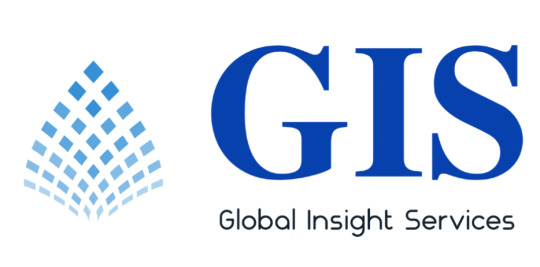
Advanced Automated First Aid Market is experiencing rapid evolution, driven by a surge in demand for intelligent, life-saving technologies. Valued at $4.2 billion in 2024, the market is projected to grow at an impressive CAGR of 8.8%, reaching $9.8 billion by 2034. This market encompasses a wide range of smart first aid solutions — automated external defibrillators (AEDs), wearable tech, AI-powered assistance devices, and cloud-connected platforms — designed to drastically reduce emergency response times and improve patient outcomes in both professional and public settings.
Market Dynamics
The momentum in this market is largely powered by technological innovations, rising workplace safety regulations, and a heightened global focus on health preparedness. Wearable devices currently dominate the landscape, holding 45% of the market share thanks to their integration with smart health monitoring systems and real-time alert mechanisms. Medical drones follow closely, revolutionizing response strategies in remote or inaccessible areas. With industries like construction, sports, public venues, and offices adopting automated solutions, the demand continues to expand.
Click to Request a Sample of this Report for Additional Market Insights: https://www.globalinsightservices.com/request-sample/?id=GIS10816
However, the market also faces hurdles — high initial costs, complex integration into legacy medical systems, and low awareness in developing regions. Regulatory compliance adds another layer of challenge, often slowing market penetration and requiring vendors to maintain agile development cycles.
Key Players Analysis
Market leadership is currently shaped by major players such as Zoll Medical, Medtronic, Philips Healthcare, and Stryker, who leverage innovation and strategic partnerships to remain at the forefront. These companies are investing heavily in AI, IoT, and machine learning to make devices not only smarter but more intuitive for non-medical users. Startups like First Aid Pro Tech and Rescue Bot Innovations are emerging disruptors, introducing AI-based rapid response systems and modular smart kits aimed at underserved markets. The competitive landscape is becoming increasingly collaborative, with joint ventures between healthcare providers and tech firms driving ecosystem-based solutions.
Regional Analysis
North America leads the global market, driven by an advanced healthcare infrastructure, high public awareness, and early adoption of automated technologies. The U.S. remains a key player, with widespread AED deployment in schools, airports, and workplaces.
Europe is close behind, with countries like Germany and the UK pushing innovation due to stringent occupational safety mandates. Public health campaigns and government subsidies further support device integration in public and private spaces.
In Asia-Pacific, growth is being fueled by rapid industrialization, particularly in China and India. These markets are investing in healthcare modernization and emphasizing emergency preparedness across urban centers and large corporations.
Latin America and the Middle East & Africa show steady but slower progress due to economic and infrastructural limitations. However, increasing awareness and international aid programs are beginning to catalyze adoption.
Recent News & Developments
The industry has seen transformative shifts in pricing, features, and accessibility. Prices range from $100 to $500 depending on device capabilities, with affordability becoming a strategic priority. Key developments include the launch of predictive maintenance tools and user-friendly interfaces that simplify device operation for everyday users. Companies like Philips are integrating AI-driven insights for proactive diagnostics, while drone-based aid delivery systems are being piloted in disaster-prone areas. Strategic partnerships across tech, healthcare, and education sectors are fostering holistic emergency ecosystems that combine software, hardware, and real-time data analytics.
Browse Full Report : https://www.globalinsightservices.com/reports/advanced-automated-first-aid-market/
Scope of the Report
This report delves into comprehensive market metrics, forecasting trends from 2025 to 2034 across device types, technology platforms, service models, and deployment strategies. It offers insights on consumer demographics, regulatory environments, competitive benchmarking, and cross-segment synergies. With a focus on production-consumption dynamics and global trade flows, the research helps businesses align with emerging opportunities, minimize risk, and drive long-term growth in a high-stakes, rapidly advancing market.
Discover Additional Market Insights from Global Insight Services:
Biodegradable Implant Devices Market : https://www.globalinsightservices.com/reports/biodegradable-implant-devices-market/
Cuffless Blood Pressure Monitor Market : https://www.globalinsightservices.com/reports/cuffless-blood-pressure-monitor-market/
Endoscope Reprocessing Market : https://www.globalinsightservices.com/reports/endoscope-reprocessing-market/
Healthcare Simulation Market : https://www.globalinsightservices.com/reports/healthcare-simulation-market/
Biodegradable Implant Devices Market : https://www.globalinsightservices.com/reports/biodegradable-implant-devices-market/
#firstaid #automatedfirstaid #aed #smarthealth #aihealthcare #wearabletech #emergencyresponse #medicaldevices #healthtech #remotemonitoring #iothealth #futureofmedicine #digitalsafety #publichealth #medtech #defibrillators #firstresponders #healthcareinnovation #workplacesafety #corporatehealth #smartdevices #dronetech #disasterresponse #militaryhealth #sportsafety #cloudhealth #smartbandages #automatedsystems #aiinmedicine #techenabledcare #emergencycare #roboticfirstaid #digitalhealth #responsetech #occupationalhealth #lifesavingtech #safetyequipment #realtimedata #predictivehealth #intelligentcare
About Us:
Global Insight Services (GIS) is a leading multi-industry market research firm headquartered in Delaware, US. We are committed to providing our clients with highest quality data, analysis, and tools to meet all their market research needs. With GIS, you can be assured of the quality of the deliverables, robust & transparent research methodology, and superior service.
Contact Us:
Global Insight Services LLC 16192, Coastal Highway, Lewes DE 19958 E-mail: [email protected] Phone: +1–833–761–1700 Website: https://www.globalinsightservices.com/
0 notes
Text
Defibrillator Market Competitive Landscape and Key Players Analysis 2032
In 2018, the global defibrillator market was worth about USD 9.8 billion and is expected to grow to over USD 21.1 billion by 2032, with a steady annual growth rate of 5.7%. North America led the market in 2018, holding nearly 45% of the total market share.
The defibrillator market encompasses the development and distribution of devices designed to restore normal heart rhythm in patients experiencing sudden cardiac arrest or life-threatening arrhythmias. These devices include implantable cardioverter defibrillators (ICDs), external defibrillators, and automated external defibrillators (AEDs), each serving different clinical needs and settings. Growing awareness about cardiovascular diseases, advancements in defibrillator technology, and increasing efforts to make these life-saving devices accessible in public places are driving market growth. The demand is also fueled by the rising prevalence of heart conditions worldwide and improvements in emergency response infrastructure. As innovations continue to enhance the functionality and ease of use of defibrillators, the market is expected to expand steadily across various healthcare environments globally.
Tariff Impact Analysis for Defibrillator Market: https://www.fortunebusinessinsights.com/industry-reports/defibrillator-market-100950
Defibrillator Market Overview:
The defibrillator market is experiencing significant growth, driven by the increasing prevalence of cardiovascular diseases and heightened awareness of sudden cardiac arrest (SCA). Technological advancements, such as the development of automated external defibrillators (AEDs) and implantable cardioverter defibrillators (ICDs), have enhanced the efficacy and accessibility of defibrillation therapies. The market is further propelled by initiatives aimed at improving emergency response systems and the integration of defibrillators in public spaces.
List Of Companies Profiled In Defibrillator Market:
Asahi Kasei Corporation
Philips Healthcare
Defibtech, LLC.
Cardiac Science
Stryker
CU Medical System Inc.
Medtronic
Boston Scientific Corporation
Biotronik
LivaNova Plc
Abbott
Microport
Other prominent players
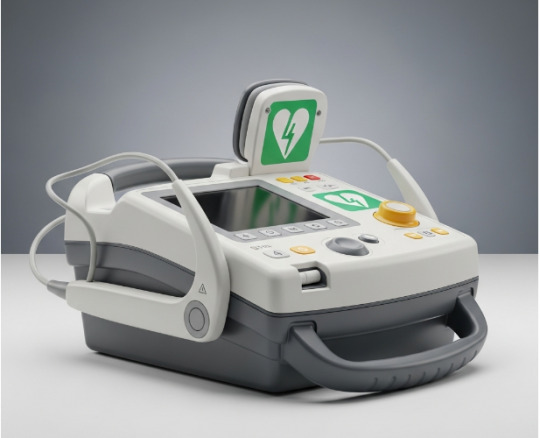
Market Segmentation:
In terms of segmentation, the defibrillator market is categorized based on product type and end user. Product types include implantable cardioverter defibrillators, which are inserted into patients at high risk of life-threatening arrhythmias, and external defibrillators, such as AEDs and manual units used in clinical and non-clinical settings. Wearable defibrillators also form a growing segment, offering non-invasive and temporary protection for patients not yet eligible for an implantable device. By end use, the market spans hospitals and clinics, which remain the dominant users due to their capacity for advanced cardiac care, as well as public access environments where AEDs serve as critical tools for first response. Emergency medical services and home care applications are also increasingly adopting defibrillator solutions to enhance cardiac event survival rates outside traditional clinical settings.
Restraining Factors:
The defibrillator market does face certain restraining factors that could hinder its growth trajectory. High device and maintenance costs can limit access in low- and middle-income regions, while lack of awareness or inadequate training on AED usage may reduce their effectiveness in public settings. Regulatory complexities and reimbursement issues can also delay the adoption of newer technologies in some markets.
Regional Insights:
Regionally, the defibrillator market is led by North America, owing to its advanced healthcare infrastructure, strong presence of key market players, and widespread public and private investment in cardiac health. Europe follows closely, supported by favorable healthcare policies and increasing incidence of cardiovascular conditions. The Asia-Pacific region is expected to witness the fastest growth, driven by improving healthcare systems, rising disposable income, and growing efforts to modernize emergency care. Latin America and the Middle East & Africa present emerging opportunities, though market growth in these regions remains dependent on economic development and healthcare accessibility.
Key Industry Updates:
July 2021 – ZOLL Medical received U.S. FDA approval to launch a brain injury monitoring feature on its defibrillators in the U.S., helping doctors make better decisions for trauma patients.
Contact us:
Fortune Business Insights™ Pvt.
Phone: USA: +1 833 909 2966 (Toll-Free),
United Kingdom: +44 808 502 0280 (Toll-Free)
APAC: +91 744 740 1245
Email: [email protected]
0 notes